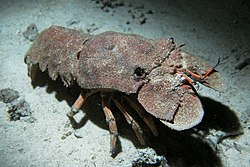| Achelata Temporal range: | |
|---|---|
 | |
| The phyllosoma larva is characteristic of the Achelata (drawing by Haeckel) | |
| Scientific classification | |
| Domain: | Eukaryota |
| Kingdom: | Animalia |
| Phylum: | Arthropoda |
| Class: | Malacostraca |
| Order: | Decapoda |
| Suborder: | Pleocyemata |
| Clade: | Reptantia |
| Infraorder: | Achelata Scholtz & Richter, 1995 |
| Families [1] | |
The Achelata is an infra-order of the decapod crustaceans, holding the spiny lobsters, slipper lobsters and their fossil relatives.



